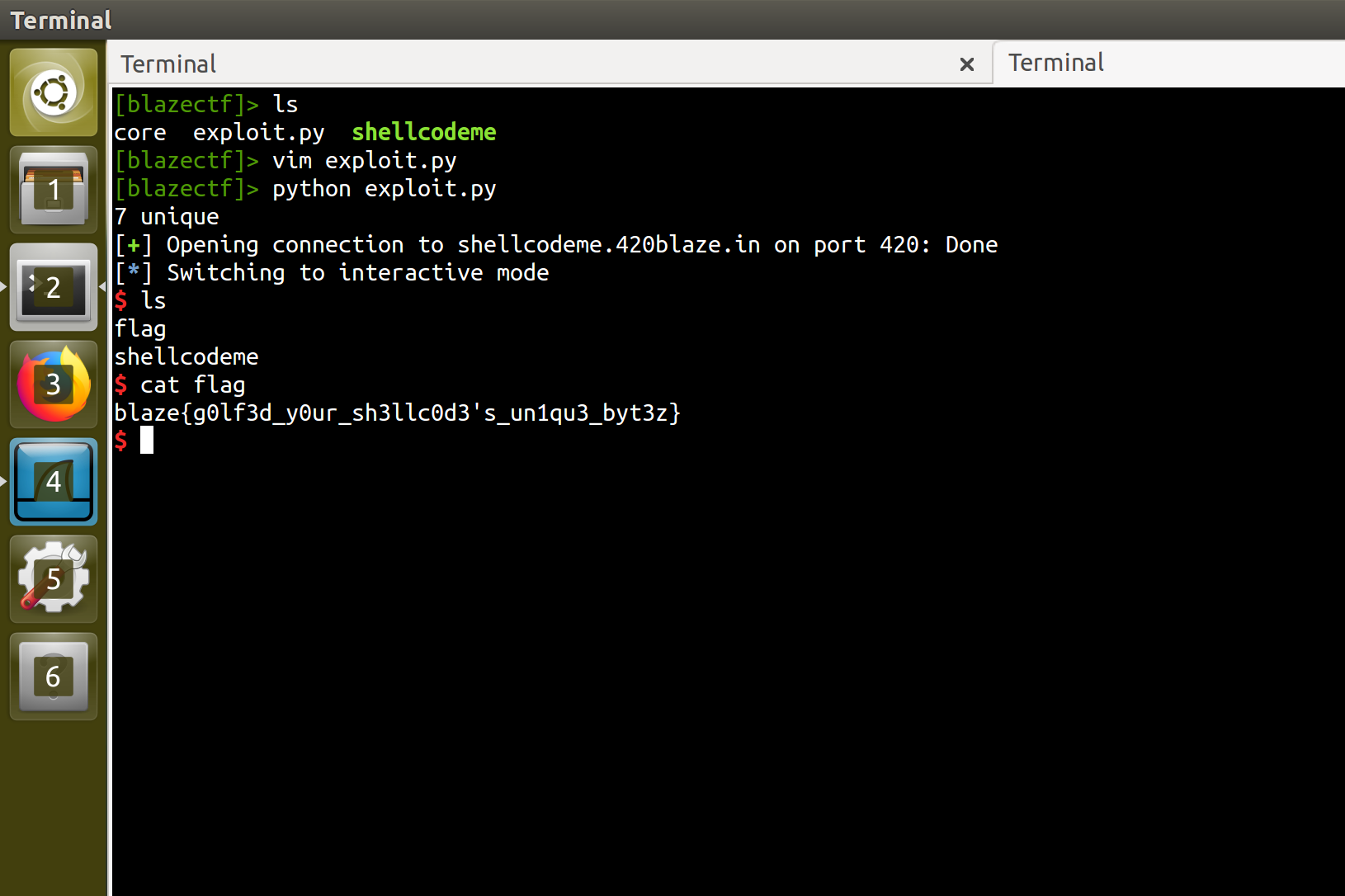Blaze CTF 2018: shellcodeme (420 pts)
Apr 23, 2018This was a simply-posed but tricky pwnable that ghostly_gray and I solved over the course of a long plane ride. We were given the source code (shown below) as well as the binary. Simply put, we had to write some x86-64 shellcode that used no more than 7 distinct bytes.
// gcc -zexecstack -Os shellcodeme.c -o shellcodeme
#include <stdio.h>
#include <string.h>
#include <sys/mman.h>
#include <unistd.h>
#define BUF_SIZE (0x4096 & ~(getpagesize()-1))
int main() {
setbuf(stdout, NULL);
unsigned char seen[257], *p, *buf;
void (*f)(void);
memset(seen, 0, sizeof seen);
buf = mmap(0, BUF_SIZE, PROT_READ | PROT_WRITE | PROT_EXEC, MAP_PRIVATE | MAP_ANONYMOUS, -1, 0);
puts("Shellcode?");
fgets(buf, BUF_SIZE, stdin);
fflush(stdin);
for(p=buf; *p != '\n'; p++) {
seen[256] += !seen[*p];
seen[*p] |= 1;
}
if(seen[256] > 7) {
puts("Shellcode too diverse.");
_exit(1);
} else {
*(void**)(&f) = (void*)buf;
f();
_exit(0);
}
}
Initial Work
We had no clue whether ASLR was on or off, and system wasn’t anywhere to be found in the binary, so our first approach was to make a syscall to execve with “/bin/sh” as an argument.
This went… poorly. Despite our best efforts we couldn’t manage to do this with less than 11 distinct bytes. The problem was there were simply too many steps involved with setting up the syscall. We had to:
- Push
0x68732f6e69622f2fonto the stack (“/bin/sh”) - Point
rditowards it (first argument) - Set
raxto 59 (syscall number forexecve) - Set
rsiandrdxto 0 (2nd and 3rd arguments need to be NULL) - Make the syscall (2 byte instruction)
In the process of struggling, we did come up with a fairly efficient way of getting an arbitrary value in a register. The two instructions inc eax and add eax, eax use only three unique bytes between them and allow you to increment or double the value in the eax register. By following the binary representation of a number X from left to right, we can repeatedly apply these two instructions to set eax to X using only a logarithmic number of instructions.
For example, to set eax to 13 = 0b1101, we apply:
inc eax
add eax, eax
inc eax
add eax eax
add eax eax
inc eax
doubling after every bit, and incrementing after every bit that is a 1. (This is reminiscent of exponentiation by squaring or the double-and-add elliptic curve point multiplication algorithm).
Still, with only 4 bytes left to spare, we couldn’t figure out how to call syscall and set the values of four different registers. So, we started looking for tricks.
I began trying to overflow the value in seen[256] which keeps track of the number of distinct characters. I reasoned that if we sent some shellcode that used all 256 different bytes, it would overflow to 0 and pass the “< 7” check. Alas, it was impossible to send a “\n” character without terminating the fgets, so the maximum value of seen[256] seemed to be 255.
However, this did lead us to a working strategy: use our shellcode to modify the value of seen[256] to something large and then jump back earlier in main (after the memset) to redo the fgets. Then send some standard, diverse shellcode which will overflow seen[256] to something less than 7.
The Attack
In the assembly, seen[256] was located at rsp + 0x107. Here was our strategy:
- Set
eaxto 0x107 using the double-and-add trick - Call
mov BYTE PTR[rsp + rax], 240 - Set
eaxto 0x40069b (the start of themmapcall) using the double-and-add trick - Call
jmp rax - Send some standard shellcode in the second call to
fgets - Win
Critically, we had to construct the first payload to use no more than 7 distinct bytes. Our super-efficient double-and-add routine made this feasible. Below we’ve shown the four assembly instructions we used and their assembled byte sequences.
| Instruction | Assembly |
|---|---|
inc eax |
\xff\xc0 |
add eax, eax |
\x01\xc0 |
mov BYTE PTR[rsp + rax], 240 |
\xc6\x04\x04\xf0 |
jmp rax |
\xff\xe0 |
Our standard shellcode uses 19 distinct bytes, so this results in seen[256] having a value of 240 + 19 = 259 == 3 < 7.
You can read our full exploit script here. Running it against the server pops a shell, letting us read the flag: blaze{g0lf3d_y0ur_sh3llc0d3's_un1qu3_byt3z}.
